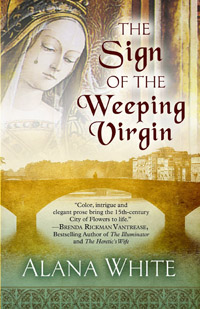Renaissance Intrigue
Alana White’s passion for Renaissance Italy results in a fascinating historical mystery
In The Sign of the Weeping Virgin, the debut novel by Nashvillian Alana White, Guid’Antonio Vespucci and his nephew Amerigo return from a two-year diplomatic mission to Paris only to find their native Florence in disarray. A young woman has been kidnapped, supposedly by the infidel Turks, and a painting of the Virgin Mary is weeping in the Vespucci home church. In fifteenth-century Italy, these events are equally disturbing. Many in Florence believe the Virgin is weeping over Lorenzo Medici’s long argument with Pope Sixtus IV. Rebellion and mutiny are in the air.
 Guid’Antonio, a lawyer and diplomat, knows that there are no Turks attacking young women in this part of Italy, and he believes that the weeping Virgin is more man-made than divine. But he also knows that he will need to solve both mysteries if he is to ensure Lorenzo’s continued safety and rule over the city. Guid’Antonio has always been loyal to the Medici family, and he is haunted by his inability to save Giuliano Medici, his friend and Lorenzo’s brother, from assassination by political rivals in Florence Cathedral: “Guid’Antonio’s eyes flicked toward Lorenzo, and then back again. He did not see Bandini’s axe till the blade flashed in the candlelight and sliced down on Giuliano’s head. After that, time slowed down, as if luxuriously uncoiling itself in a long dark strand.” Still, loyalty and guilt are not Guid’Antonio’s only concerns. After all, this is Renaissance Italy, where being on the wrong side of a political fight can result in the loss of family honor, wealth, and—as Giuliano’s murder made shockingly clear—even life.
Guid’Antonio, a lawyer and diplomat, knows that there are no Turks attacking young women in this part of Italy, and he believes that the weeping Virgin is more man-made than divine. But he also knows that he will need to solve both mysteries if he is to ensure Lorenzo’s continued safety and rule over the city. Guid’Antonio has always been loyal to the Medici family, and he is haunted by his inability to save Giuliano Medici, his friend and Lorenzo’s brother, from assassination by political rivals in Florence Cathedral: “Guid’Antonio’s eyes flicked toward Lorenzo, and then back again. He did not see Bandini’s axe till the blade flashed in the candlelight and sliced down on Giuliano’s head. After that, time slowed down, as if luxuriously uncoiling itself in a long dark strand.” Still, loyalty and guilt are not Guid’Antonio’s only concerns. After all, this is Renaissance Italy, where being on the wrong side of a political fight can result in the loss of family honor, wealth, and—as Giuliano’s murder made shockingly clear—even life.
The Sign of the Weeping Virgin brings to life the complexities and contradictions of Renaissance Florence. The wealthy walk the same streets with the poor and hungry, where starving dogs are grateful for a bit of spat-out cheese. The Church harbors not only the saintly but also the greedy, the lascivious, and the ambitious. Artists like Botticelli and Da Vinci create works that will be considered some of the most beautiful in history, but their eyes are always on pleasing their patrons. And they too are aware of the greater political implications of a war between Lorenzo Medici and the Pope. After all, there’s a brand new chapel in Rome (the Sistine) that will soon bring works to the right skilled artists.
 White makes Guid’Antonio a compelling protagonist. Like any good Florentine politician, he has made many compromises and is not always comfortable with them. Giuliano’s death still haunts him. He loves his wife and son but has returned from France not quite sure of the former and almost a stranger to the latter. His loyalties are divided among his family, the Vespucci house, and the Medicis, and each of them requires more than perhaps one man can give. He sometimes wonders if he can keep his own household together, let alone Florence: “He felt like a man hurtling down a snowy mountain slope, while an avalanche pounded after him with such force, it seem bound to crush him beneath its awesome weight.”
White makes Guid’Antonio a compelling protagonist. Like any good Florentine politician, he has made many compromises and is not always comfortable with them. Giuliano’s death still haunts him. He loves his wife and son but has returned from France not quite sure of the former and almost a stranger to the latter. His loyalties are divided among his family, the Vespucci house, and the Medicis, and each of them requires more than perhaps one man can give. He sometimes wonders if he can keep his own household together, let alone Florence: “He felt like a man hurtling down a snowy mountain slope, while an avalanche pounded after him with such force, it seem bound to crush him beneath its awesome weight.”
White seamlessly mixes history with fiction, making readers feel as if they too are being pursued on dangerous Florentine streets in the middle of the night or wondering if a decision to be loyal will result in continued fortune or complete ruin. And she manages to convey the crazy complexity of fifteenth-century Italian politics without ever slipping into lecture mode. The Sign of the Weeping Virgin is a wonderful treat for readers who enjoy historical mysteries, Italy, and beautiful writing. Here’s hoping we’ll be treated to more adventures with Guid’Antonio and the Vespucci family.


